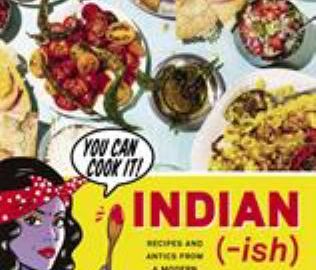
Bibliobites in March: Virtual-ish
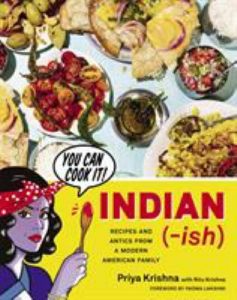 Every day, lots of us cook in an ish-ful way. Even if we didn’t grow up with an Italian nonna, or a Mexican abuela, or a Greek yia-yia, we nevertheless make foods that approximate, in some way, what those grandmothers might recognize as “theirs.” And as we become more familiar with cuisines from places like Thailand, Korea, or India, we’re adding them to our ish repertoire. This month’s title, Indian-ish, exemplifies this mashup trend: namesake flavors combined with typical American ingredients and techniques to create something not quite, yet recognizably part of, a traditional cuisine.
Every day, lots of us cook in an ish-ful way. Even if we didn’t grow up with an Italian nonna, or a Mexican abuela, or a Greek yia-yia, we nevertheless make foods that approximate, in some way, what those grandmothers might recognize as “theirs.” And as we become more familiar with cuisines from places like Thailand, Korea, or India, we’re adding them to our ish repertoire. This month’s title, Indian-ish, exemplifies this mashup trend: namesake flavors combined with typical American ingredients and techniques to create something not quite, yet recognizably part of, a traditional cuisine.
Most of us would probably admit to being a little intimidated about cooking Indian food. Sure, we love the food at Indian restaurants, but the flavors and ingredients are just exotic enough that it seems….complicated? Confusing? Outside of our comfort zone? The book’s author, Priya Krishna, addresses our anxieties head-on, with commonsense advice and a very helpful spice chart! There’s also an FAQ chapter to further demystify things. The author’s tone is friendly and funny, and she takes pains to illustrate that, as she says, Indian food is everyday food. The book itself is the typical large format, with plenty of vibrant photographs as well as some pop-art style drawings that add to the contemporary vibe. Most recipes fit on one page, and are, as the author insists, quick enough to put together on a weeknight.
Let’s take a moment to address the spice question: yes, some spices require either a trip to an Indian grocery (where those spices will be very reasonably priced), or ordering online. But, many large supermarkets carry at least the basics (like cumin, coriander, cardamom, turmeric), and with this book you could get pretty far with just those. One person even scored fresh curry leaves at Market Basket, an item you might expect to find only at an Indian grocery. Other Indian-ish ingredients available at the supermarket include lentils, hot peppers, cilantro, naan, and paneer.
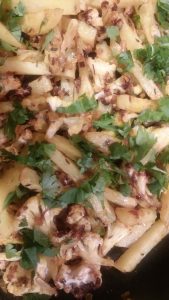 So, we’ve sourced our ingredients– what did we cook? Many Indians are vegetarians, so vegetables, grains, and lentils were front and center. Two of us tried roasted aloo gobhi, a winning combination of roasted cauliflower and potatoes. This tasty side (or main) was simple to assemble and its spicing was restrained– good for us newbies! Chickpea flour green beans
So, we’ve sourced our ingredients– what did we cook? Many Indians are vegetarians, so vegetables, grains, and lentils were front and center. Two of us tried roasted aloo gobhi, a winning combination of roasted cauliflower and potatoes. This tasty side (or main) was simple to assemble and its spicing was restrained– good for us newbies! Chickpea flour green beans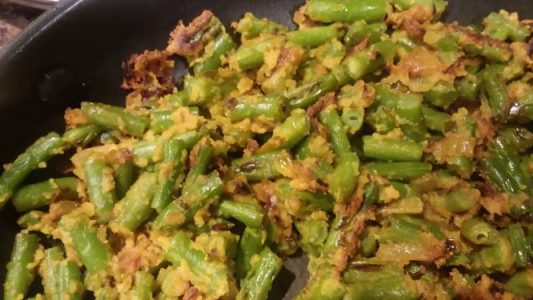 had mixed reviews; one person’s turned into “a mushy mess” (wrong pan size? Too much water?), but another’s was just right, with crunchy bits of seasoned flour enhancing the taste of the green beans. Red chile potatoes were good and quite spicy; the recipe was basic but the chile and chaat masala (a salty spice blend) kicked it up a notch. And kaddu (sweet-and-sour butternut squash) was a “very different and very good” way to serve this common veggie. This combination of sauteed squash, tomatoes, and spices was a keeper!
had mixed reviews; one person’s turned into “a mushy mess” (wrong pan size? Too much water?), but another’s was just right, with crunchy bits of seasoned flour enhancing the taste of the green beans. Red chile potatoes were good and quite spicy; the recipe was basic but the chile and chaat masala (a salty spice blend) kicked it up a notch. And kaddu (sweet-and-sour butternut squash) was a “very different and very good” way to serve this common veggie. This combination of sauteed squash, tomatoes, and spices was a keeper!
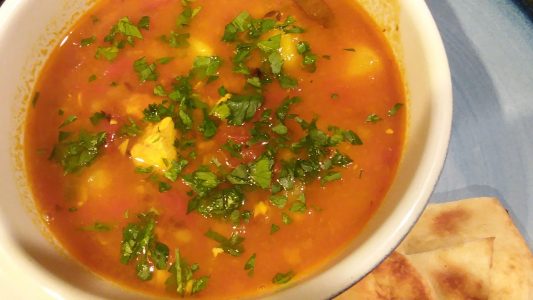 Moving on to main dishes, two of us made aloo ka rasa (spicy potato-tomato soup). This was also a fairly basic combination of ingredients that was quickly made, but the whole was greater than the sum of its parts; the spicing made it interesting, and you could add ingredients like chicken or beans to make a heartier dish. It aged well in the fridge, too. One person was on the fence about it, but for another it was a keeper. Noodle dishes turned out to be a big hit in our group: Malaysian ramen was so good, our cook made it twice; “I used less oil the second time and I liked it better that way.” Rice noodle poha was also a yummy combo of thin noodles, potatoes, chile, and lime.
Moving on to main dishes, two of us made aloo ka rasa (spicy potato-tomato soup). This was also a fairly basic combination of ingredients that was quickly made, but the whole was greater than the sum of its parts; the spicing made it interesting, and you could add ingredients like chicken or beans to make a heartier dish. It aged well in the fridge, too. One person was on the fence about it, but for another it was a keeper. Noodle dishes turned out to be a big hit in our group: Malaysian ramen was so good, our cook made it twice; “I used less oil the second time and I liked it better that way.” Rice noodle poha was also a yummy combo of thin noodles, potatoes, chile, and lime. 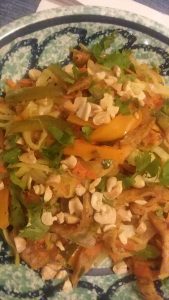 Roti noodle stir-fry featured plenty of stir-fried veggies; the roti (kind of like a tortilla) strips somehow didn’t become limp and soggy when cooked but did have the texture of tender noodles. Garlic-ginger chicken with cilantro and mint showcased some familiar flavors; the combination was tasty but “it will be better in the summer when I can make it on the grill.”
Roti noodle stir-fry featured plenty of stir-fried veggies; the roti (kind of like a tortilla) strips somehow didn’t become limp and soggy when cooked but did have the texture of tender noodles. Garlic-ginger chicken with cilantro and mint showcased some familiar flavors; the combination was tasty but “it will be better in the summer when I can make it on the grill.”
We tried a few basics, too- a couple of people made cucumber raita, which was a standard version of this familiar side. We made both the most basic dal and Priya’s dal— and neither was a big hit. The flavors of both were “kind of blah,” and Priya’s dal in particular was “very soupy.” Dal is something of a vehicle, like polenta, so perhaps we just needed to find the right thing to pair with it. A few of us planned to make cilantro chutney, as we all had lots of this herb in our crispers– it was used in almost every recipe!
Overall, we thought this book was a good introduction to Indian cooking–both its ingredients and cooking techniques. Almost all of the recipes were approachable and quick to make, and the less-familiar flavors kept us on our toes. Some spices and herbs commonly used in Indian cuisine have very definite flavors that people either love or hate (fenugreek and cilantro come to mind), so that could be a bit of an obstacle. And if you’re really into meat and poultry you’d be pretty disappointed in this book, as it was almost completely vegetarian. There were mixed reactions to all of the above, and so our voting averaged out to a 3.2 (out of a possible 5).
You might not be able to tell from what I’ve written so far, but as a result of the coronavirus pandemic and its stay-at-home directive, our meeting took place virtually. Thank you to everyone who participated, and those who tried to! Technology isn’t perfect and I know a few people couldn’t work out the glitches. But you’ll have another chance, as we’ll meet virtually again on Friday April 24 at 11 AM. This month, please choose a cookbook from one of our downloadable resources, either Overdrive or Hoopla. We’ll have a variety of recipes to discuss, as well as our experiences of using a non-paper resource. Stay safe, stay well, and happy cooking!






